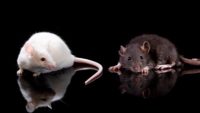Can random DNA sequences be a source of evolutionary novelty? …read more Source: creation.com
Beetles (order Coleoptera) are a unique but common group of insects easily recognized by the pair of shiny forewings covering their body. These protective wing-cases are called the elytra. Beetles make up almost 40% of the described insects in God’s creation. If all zoologists stopped what they were doing and investigated just the Coleoptera, they would easily be busy well into the next century. Beetle research … More… …read more Source: icr.org
A chemical reaction allows a tiny creature to stand out in the dark. …read more Source: creation.com
By Dr. Don DeYoung Flight engineers have discovered another source of inspiration—creatures of the sea! …read more Source: AIG Daily
German researchers described rare bone cancer in a Triassic reptile fossil found in limestone near Velberg, Germany. The find reignites conversations about the origin of diseases and ultimately of life. The team published micro-computed tomography (micro-CT) scans of the creature’s femur in the journal JAMA Oncology.1 It showed the insides of the enlarged region and confirmed the haphaz… More… …read more Source: icr.org
To the first Europeans to settle in Australia, it looked like a badger. But the creature-a godsend to shipwrecked sailors-turned out to be something very different. …read more Source: creation.com
By Ken Ham The headline of a Order your copy of Glass House today! Many people believe there’s an incredible amount of evidence for evolutionary beliefs. But most of this so-called evidence doesn’t actually support evolution the way that it is claimed to. We detail this finding regarding many common evolutionary arguments such as chromosome 2 fusion, the horse sequence, whale evolution, and so much more in our brand-new book Glass House: Shattering the Myth of Evolution. Glass House features chapters from a powerful team of credentialed scientists, researchers, and biblical apologists as they take on the pillars of evolution. [More]
The idea that the samurai face on the Heike crab was designed by natural selection isn’t true. …read more Source: <a href=https://creation.com/a/13257 target=_blank title="The Samurai Crab” >creation.com
Answering genetics questions from our readers. …read more Source: creation.com
Why this is an important issue for Flood geology. Read Article
Water dwellers have intricate design features that can be mimicked to help build better protective gear. Read Article
Hagfish look creepy. They can act creepy, too. Having no bones, they tie themselves into sliding figure eight knots that help them tear mouthfuls of flesh from the seafloor carcasses on which they feed. And don’t squeeze one unless you want an armload of instantly-expanding slime. Unique slime glands positioned along the sides of their long, slender bodies eject slime-making proteins that fill the gills of would-be predators. A newly … More… …read more Source: icr.org
Killifish have been found living in polluted rivers with levels of industrial toxins 8,000 times the lethal dose. …read more Source: creation.com
The male reproductive system is not poorly designed. Read Article
A tiny, amazing, colorful arachnid ‘struts’ around like the bird after which it is named. Read Article
By Laura Allnutt The penguin is a common favorite among children and adults, bird lovers, and cartoonists. Here are some fun facts about a fun bird on Penguin Awareness Day. …read more Source: AIG Daily
By Harry F. Sanders, III Since an increase of information is needed for molecules-to-man evolution, evolutionists postulate polyploidy as a means for this. …read more Source: AIG Daily
By Melinda Christian Scientists have long tried to understand how geckos can walk on walls and ceilings, even on smooth glass. …read more Source: AIG Daily
By Harry F. Sanders, III Modern classification is largely dependent on a technique known as cladistics. …read more Source: AIG Daily
Think of all the jobs that our good working sense of smell fulfills. First, the nose detects a chemical—the source of the scent. It distinguishes that scent from literally billions of others. Our sense of smell even gauges the strength of the scent. Finally, the sense rapidly scans memories of past smells to interpret the odor’s level of pleasure or toxicity or something in between. Human engineers would need a large lab full of… More… …read more Source: icr.org
The junk DNA paradigm has proven to be an ill-founded icon of evolution. We’ve witnessed its pet sub-theories systematically debunked as we learn more and more about how creatures’ DNA systems work. And now one of the pet darlings of junk DNA speculation, the alleged useless nature of introns (intervening noncoding pieces of genes), has also been tossed in the evolutionary trash heap. When scientists first… More… …read more Source: icr.org
Sneak peek of latest Creation magazine.’Extreme’ living fossils shout ‘after their kind’ …read more Source: creation.com
Jeffrey P. Tomkins, Ph.D. and Timothy L. Clarey, Ph.D. Red algae form one of the main components of coral reefs and were originally thought to have appeared on Earth during the middle of the Cretaceous system about 100 million years ago. At least that’s what the standard evolutionary story claimed until the same type of fossils were just discovered in Silurian system roc… More… …read more Source: icr.org
There is more than one view among evolutionary researchers on how new biological structures arise. …read more Source: creation.com
by Frank Sherwin and Jeff Tomkins, Ph.D. Australian and American zoologists discovered a new species of shark.1Carcharhinus obsolerus was discovered off the coast of South East Asia but has not been found anywhere in the past eight decades. Based on the morphology of the find’s teeth and fins, researchers have concluded it’s a new species of shark, but … More… …read more Source: icr.org
Secular geologists have long claimed that oil can survive millions of years underground because it somehow becomes pasteurized at 80 oC (176 oF), preventing further biodegradation.1 These geologists argue that oil can be preserved for millions of years because the subsurface temperatures are simply too hot for microbial activity. And once the oil is pasteurized (heated enough to destroy microorganisms) and t… More… …read more Source: icr.org
By Ken Ham Researchers have announced what they believe to be the oldest flowering plant, a flower with a tree-shaped style and spoon-shaped petals from the early Jurassic, some supposed 174 million years ago. The fossils of this plant were examined with high-powered microscopes that revealed it was an angiosperm, a specific group of plants that have flowers and enclosed seeds. One researcher describes the origin of angiosperms as a long “academic headache,” and the lead author of this new paper on this fossilized flower comments, Researchers were not certain where and how flowers came into existence, because it seems [More]









































